Esperanza Base
Esperanza Base (Spanish: Base Esperanza, 'Hope Base') is a permanent, all-year-round Argentine research station in Hope Bay, Trinity Peninsula (in Graham Land on the Antarctic Peninsula). It is one of only two civilian settlements in Antarctica (the other being the Chilean Villa Las Estrellas). The base's motto is Permanencia, un acto de sacrificio ('Permanence, an act of sacrifice').
Esperanza Base Base Esperanza | |
|---|---|
All-civilian Antarctic base | |
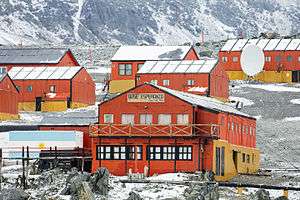 View of Esperanza Base, January 2016 | |
 Emblem | |
| Motto(s): Spanish: Permanencia, un acto de sacrificio ("Permanence, an act of sacrifice") | |
 Esperanza Base Location of Esperanza Base in Antarctica | |
| Coordinates: 63°23′51″S 56°59′52″W | |
| Country | |
| Region | |
| Location | |
| Administered by | Argentine Antarctic Institute (under the supervision of the Argentine National Antarctic Directorate) |
| Established | 1953 |
| Named for | Spanish: Base Esperanza ("Hope Base") |
| Area | |
| • Urban | 0.3744 ha (0.9252 acres) |
| Elevation | 25 m (82 ft) |
| Population (2014) | 55 |
| Type | All-year round |
| Period | Annual |
| Status | Operational |
Description
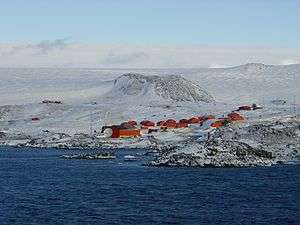
Built in 1953,[1][2][3] the base houses 55 inhabitants in winter, including 10 families and 2 school teachers. Provincial school #38 Presidente Raúl Ricardo Alfonsín (formerly named Julio Argentino Roca) was founded in 1978 and acquired independent status in 1997. It maintains the furthest South Scout troop. The base has an Argentine civil register office where births and weddings are recorded.[4] The base has tourist facilities that are visited by about 1,100 tourists each year. The LRA 36 Radio Nacional Arcángel San Gabriel radio station started transmitting in 1979 and currently broadcasts on shortwave and FM. A wind generator was installed in 2008, mounted by INVAP.[5]
The 43 buildings of the station have a combined space of 3,744 square metres (40,300 sq ft) covered;[6] 18,000 litres (4,800 US gal) of fuel are used annually by the four generators to produce electricity for the station. Research projects include: glaciology, seismology, oceanography, coastal ecology, biology, geology, and limnology.
This place was also the scene of the first ever shots fired in anger in Antarctica in 1952 when an Argentine shore party fired a machine gun over the heads of a British Antarctic Survey team unloading supplies from the John Biscoe. The Argentines later extended a diplomatic apology, saying that there had been a misunderstanding and that the Argentine military commander on the ground had exceeded his authority. A series of incidents in the area had begun during World War II. The Antarctic Treaty of 1959, treats the continent as a laboratory open to all, and provides that "no acts or activities ... shall constitute a basis for asserting, supporting or denying a claim to territorial sovereignty."[7]
People
The base was the birthplace of Emilio Palma, the first person to be born in Antarctica. There have been at least ten other children born at the base.[8][9]
Climate
Like the rest of the Antarctic Peninsula, the base has a polar climate characterized by strong winds that descend downwards from the Antarctic ice sheet.[10] These winds can exceed 250 km/h (160 mph), leading to blowing snow and reduced visibility.[10] The climate is classified as a polar tundra (ET) climate in the Köppen system.[11]
Mean monthly temperatures range from −10.5 °C (13.1 °F) in July, the coldest month, to 1.4 °C (34.5 °F) in January, the warmest month.[10] During summer (December–February), the average high is between 3.7 and 4.3 °C (38.7 and 39.7 °F) while the average low is between −2.0 and −1.2 °C (28.4 and 29.8 °F).[10] In winter, mean temperatures are around −6.0 °C (21.2 °F).[10] A temperature of 17.5 °C (63.5 °F) was recorded on 24 March 2015.[12] This reading was the highest temperature ever recorded on mainland Antarctica and its surrounding islands, until on 6 February 2020, a new high of 18.3 °C (64.9 °F) was recorded at the base, being the current record. [13] The lowest temperature ever recorded is −38.4 °C (−37.1 °F) on 18 July 1994.[14]
The temperature trend since 1948 is +0.0315 °C/yr (+0.0567 °F/yr) (annual), +0.0413 °C/yr (+0.0743 °F/yr) (winter) and +0.0300 °C/yr (+0.0540 °F/yr) (summer).
| Climate data for Esperanza (1981–2010, extremes 1945–present) | |||||||||||||
|---|---|---|---|---|---|---|---|---|---|---|---|---|---|
| Month | Jan | Feb | Mar | Apr | May | Jun | Jul | Aug | Sep | Oct | Nov | Dec | Year |
| Record high °C (°F) | 14.9 (58.8) |
18.3 (64.9) |
17.5 (63.5) |
15.9 (60.6) |
17.2 (63.0) |
13.3 (55.9) |
14.0 (57.2) |
13.0 (55.4) |
11.4 (52.5) |
17.0 (62.6) |
14.3 (57.7) |
14.6 (58.3) |
18.3 (64.9) |
| Average high °C (°F) | 4.3 (39.7) |
3.7 (38.7) |
1.2 (34.2) |
−2.1 (28.2) |
−4.0 (24.8) |
−6.2 (20.8) |
−6.3 (20.7) |
−4.6 (23.7) |
−2.3 (27.9) |
−0.4 (31.3) |
2.1 (35.8) |
3.8 (38.8) |
−0.9 (30.4) |
| Daily mean °C (°F) | 1.4 (34.5) |
0.7 (33.3) |
−2.3 (27.9) |
−6.1 (21.0) |
−8.2 (17.2) |
−10.4 (13.3) |
−10.5 (13.1) |
−9.0 (15.8) |
−6.5 (20.3) |
−4.3 (24.3) |
−1.1 (30.0) |
0.8 (33.4) |
−4.6 (23.7) |
| Average low °C (°F) | −1.2 (29.8) |
−2.0 (28.4) |
−5.6 (21.9) |
−9.7 (14.5) |
−12.1 (10.2) |
−14.3 (6.3) |
−14.8 (5.4) |
−13.2 (8.2) |
−10.4 (13.3) |
−8.0 (17.6) |
−4.2 (24.4) |
−1.9 (28.6) |
−8.1 (17.4) |
| Record low °C (°F) | −8.5 (16.7) |
−13.2 (8.2) |
−20.9 (−5.6) |
−26.0 (−14.8) |
−29.6 (−21.3) |
−30.0 (−22.0) |
−38.4 (−37.1) |
−32.0 (−25.6) |
−32.6 (−26.7) |
−23.2 (−9.8) |
−18.0 (−0.4) |
−9.7 (14.5) |
−38.4 (−37.1) |
| Average precipitation mm (inches) | 56.2 (2.21) |
65.0 (2.56) |
75.5 (2.97) |
59.1 (2.33) |
54.4 (2.14) |
47.4 (1.87) |
54.1 (2.13) |
72.1 (2.84) |
62.2 (2.45) |
56.4 (2.22) |
65.0 (2.56) |
59.0 (2.32) |
726.4 (28.60) |
| Average precipitation days (≥ 0.1 mm) | 14 | 14 | 17 | 17 | 14 | 11 | 13 | 15 | 15 | 15 | 16 | 16 | 177 |
| Average snowy days | 16 | 15 | 16 | 16 | 14 | 13 | 14 | 14 | 16 | 15 | 16 | 16 | 181 |
| Average relative humidity (%) | 82 | 80 | 80 | 80 | 80 | 79 | 80 | 80 | 79 | 80 | 81 | 80 | 80 |
| Mean monthly sunshine hours | 93.0 | 127.1 | 89.9 | 60.0 | 31.0 | 12.0 | 21.7 | 43.4 | 87.0 | 136.4 | 144.0 | 161.2 | 1,006.7 |
| Mean daily sunshine hours | 3.0 | 4.5 | 2.9 | 2.0 | 1.0 | 0.4 | 0.7 | 1.4 | 2.9 | 4.4 | 4.8 | 5.2 | 2.8 |
| Source 1: Servicio Meteorológico Nacional (temperature 1981–2010, precipitation and snowy days 1961–1990),[15][16][17] NOAA (precipitation 1961–1990)[18] | |||||||||||||
| Source 2: Meteo Climat (record highs and lows),[14] Deutscher Wetterdienst (sun, 1982–1990 and humidity, 1982–1995)[19] | |||||||||||||
Historic site
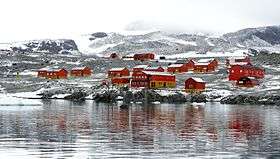 | |
 Grunden Rock lighthouse Antarctica | |
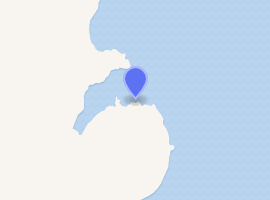
| |
| Location | Grunden Rock Lighthouse Esperanza Base Trinity Peninsula Antarctica |
|---|---|
| Coordinates | 63°23′43″S 56°58′32″W |
| Year first constructed | n/a |
| Foundation | concrete base |
| Construction | concrete tower |
| Tower shape | cylindrical tower with lantern |
| Markings / pattern | red tower with two horizontal black bands |
| Tower height | 6 metres (20 ft)[20] |
| Focal height | 26 metres (85 ft)[20] |
| Light source | solar power |
| Range | 6 nautical miles (11 km; 6.9 mi)[20] |
| Characteristic | Fl W 2s.[20] |
| Admiralty number | G1389[20] |
| NGA number | 2756[20] |
| ARLHS number | ANC-002[21] |
| Managing agent | Argentine Navy |
A group of items or structures of historic significance at, or close to, the base have been designated a Historic Site or Monument (HSM 40), following a proposal by Argentina to the Antarctic Treaty Consultative Meeting. These comprise a bust of General San Martin, a grotto with a statue of the Virgin of Lujan, a flagpole erected in 1955, and a cemetery with a stele commemorating Argentine expedition members who died in the area.[22]
General Martín Güemes Refuge
Refuge General Martín Güemes is the name given to two shelters in Antarctica. The first one is covered by ice, the second one is active. The refuge is Administered by the Argentine Army and depend on the Esperanza Base, which is responsible for the maintenance and the care. The two refuges are located on the Tabarin Peninsula on the eastern tip of the Trinity Peninsula on the Antarctic Peninsula 14 kilometres (8.7 mi) south of Esperanza.The refuges pay homage to Martín Miguel de Güemes, a military man who served an outstanding role in the Argentine war of independence.
General Martín Güemes I Refuge
The first refuge 63°29′00″S 57°00′00″W was located on the north east coast of the Duse Bay of the Trinity Peninsula and opened on October 23, 1953. Jorge Edgar Leal, at that time head of the newly created Esperanza Base, participated in its construction, being one of the first refuges installed by the Army and the second in the continental Antarctica. The refuge was destroyed by the ice in 1960.
General Martín Güemes II Refuge
The second refuge 63°30′14″S 57°07′25″W is active and is located in the Tabarin Peninsula and was inaugurated on September 15, 1959. It has capacity for six people, food for a month, fuel, gas and a first aid kit.[23]
See also
Notes
- Indoors area
References
- "Gral. Jorge Leal: un expedicionario en la Antártida". Canal Encuentro (in Spanish). Presidencia de la Nación. Archived from the original on 27 October 2014. Retrieved 20 April 2019.
- "official site". Ejército Argentino (in Spanish). Archived from the original on 6 June 2011. Retrieved 20 April 2019.
- "Base Antártica Esperanza". marambio.aq (in Spanish). Retrieved 20 April 2019.
- "Registro civil "Base Esperanza"". Ejército Argentino (in Spanish). Archived from the original on January 17, 2010. Retrieved 20 April 2019.
- INVAP (25 May 2010). IVS-4500 en Base Esperanza, Antártida Argentina - "Hielos míticos" (Daniel Bazan, 2008) (YouTube). Retrieved 20 April 2019.
- Google Earth satellite images
- "1948 (sic) BRITISH-ARGENTINE CLASHES IN ANTARCTIC ENDED PEACEFULLY". Section A: New York Times. p. 8. Retrieved 7 February 2020.
- 60 años de Base Esperanza Archived 2018-06-14 at the Wayback Machine - Fundación Marambio
- El primer antártico es argentino Archived December 6, 2014, at the Wayback Machine - Fundación Marambio
- "Base Esperanza" (in Spanish). Servicio Meteorológico Nacional. Retrieved 4 March 2017.
- Peel, M. C.; Finlayson B. L. & McMahon, T. A. (2007). "Updated world map of the Köppen−Geiger climate classification" (PDF). Hydrol. Earth Syst. Sci. 11 (5): 1633–1644. doi:10.5194/hess-11-1633-2007. ISSN 1027-5606.
- Mccarthy, Tom (31 March 2015). "Antarctica records unprecedented high temperatures in two new readings". The Guardian. Retrieved 8 July 2015.
- "New record for Antarctic continent reported". World Meteorological Organization. Retrieved 7 February 2020.
- "Station Base Esperanza" (in French). Meteo Climat. Retrieved June 6, 2016.
- "Estadísticas Climatológicas Normales - período 1981-2010" (in Spanish). Servicio Meteorológico Nacional. Retrieved January 18, 2018.
- "B. Espernza Statistical Data (1961-1990)" (in Spanish). Servicio Meteorológico Nacional. Retrieved January 23, 2016.
- "Valores Medios de Temperatura y Precipitación-Antártida: Base Esperanza" (in Spanish). Servicio Meteorológico Nacional. Retrieved January 23, 2016.
- "Base Esperanza Climate Normals 1961–1990". National Oceanic and Atmospheric Administration. Retrieved January 23, 2016.
- "Klimatafel von Esperanza (Argentinien) / Antarkt. Halbinsel / Antarktis" (PDF). Baseline climate means (1961-1990) from stations all over the world (in German). Deutscher Wetterdienst. Retrieved January 23, 2016.
- List of Lights, Pub. 111: The West Coasts of North and South America (Excluding Continental U.S.A. and Hawaii), Australia, Tasmania, New Zealand, and the Islands of the North and South Pacific Oceans (PDF). List of Lights. United States National Geospatial-Intelligence Agency. 2017.
- "Antarctica". The Lighthouse Directory. University of North Carolina at Chapel Hill. Retrieved 22 May 2017.
- "List of Historic Sites and Monuments approved by the ATCM (2012)" (PDF). Antarctic Treaty Secretariat. 2012. Retrieved 2013-12-31.
- "Refugio General Martín Güemes". Wikipedia Espanol. Wikimedia Foundation Inc. Retrieved September 18, 2018.
Further reading
- Antarctica. Sydney: Reader's Digest, 1985, p. 156-157.
- Child, Jack. Antarctica and South American Geopolitics: Frozen Lebensraum. New York: Praeger Publishers, 1988, p. 73.
- Lonely Planet, Antarctica: a Lonely Planet Travel Survival Kit, Oakland, CA: Lonely Planet Publications, 1996, 302-304.
- Stewart, Andrew, Antarctica: An Encyclopedia. London: McFarland and Co., 1990 (2 volumes), p. 469.
- U.S. National Science Foundation, Geographic Names of the Antarctic, Fred G. Alberts, ed. Washington: NSF, 1980.
External links
| Wikimedia Commons has media related to Esperanza Station. |
- Council Of Managers Of National Antarctic Programs: Base Esperanza
- Temperatures
- (in Spanish) Argentine Army's site about the base
- Official website Direccion Nacional del Antartico
- (in Spanish) Fundaciòn Marambio Esperanza Base page
- COMNAP Antarctic Facilities
- COMNAP Antarctic Facilities Map
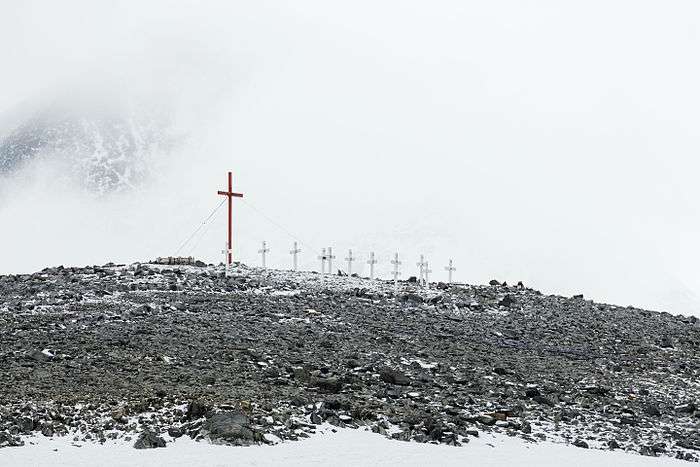
.svg.png)